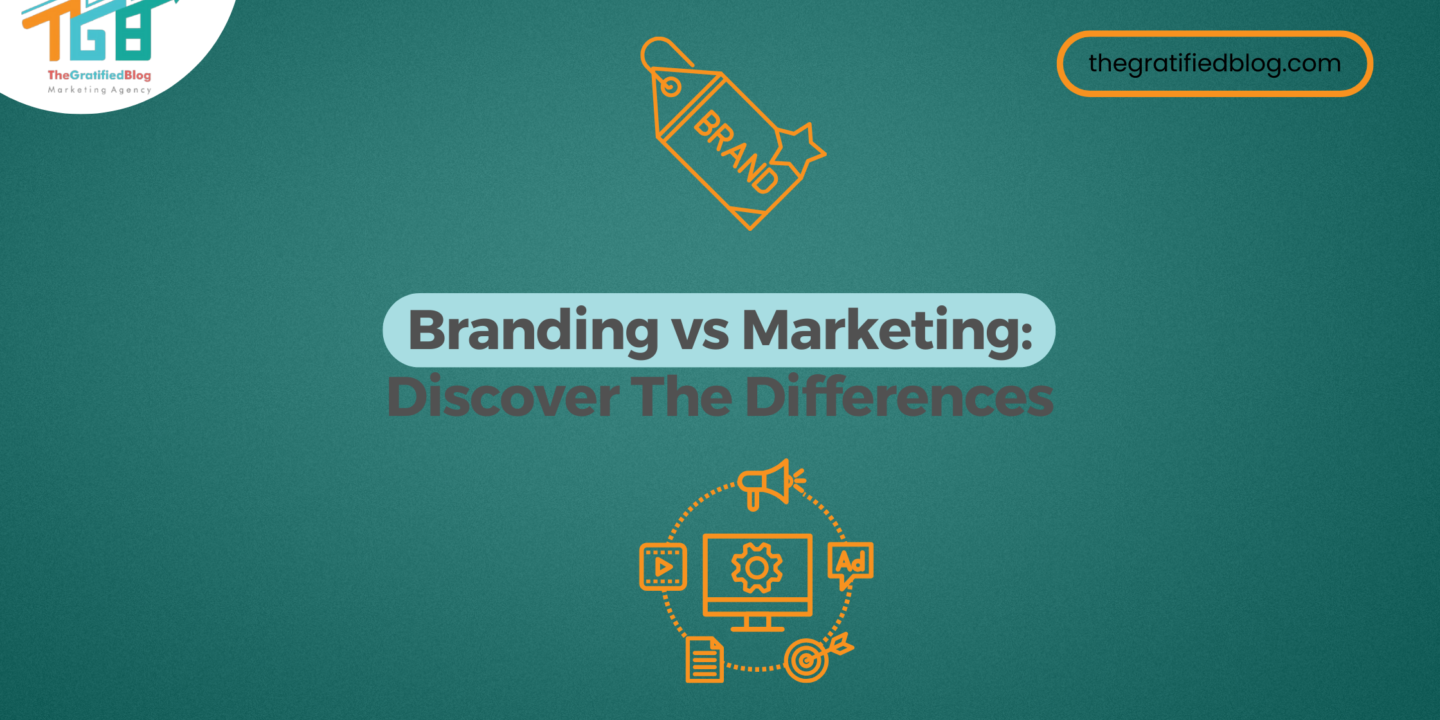
In business, “branding” and “marketing” are frequently interchanged, resulting in misunderstandings and misconceptions regarding their distinct roles and functions. However, understanding the disparity between branding vs. marketing is crucial for any organization striving to establish a strong presence in today’s competitive landscape. While both concepts are essential components of a comprehensive business strategy, they serve distinct purposes and operate on different timelines.
In this blog, we embark on a journey to unravel the complexities surrounding branding vs. marketing, delving into their definitions, core objectives, and the symbiotic relationship. By the end of this exploration, you’ll gain invaluable insights into how these two pillars of business strategy intersect and how to leverage them effectively to propel your brand towards success.
So, let’s dive in and demystify the world of branding vs. marketing
What Is Branding?
Definition of branding
Branding encompasses the strategic process of creating and shaping a distinct identity for a company, product, or service in the minds of consumers.
It goes beyond merely designing a logo or choosing a colour palette; branding involves crafting a cohesive narrative that communicates the essence and values of the brand to its target audience.
Components of branding:
- Brand identity: It refers to the visual elements and tangible aspects that represent a brand, including its logo, typography, color scheme, and design elements. It serves as the outward expression of the brand’s personality and values.
- Brand image: Brand image pertains to consumers’ perceptions and associations about a brand based on their experiences, interactions, and impressions. It reflects how a brand is perceived in the marketplace and shapes consumer attitudes and behaviour.
- Brand values: Brand values encapsulate the principles, beliefs, and ideals that a brand stands for. These values guide the decision-making process within the organization and resonate with the target audience, fostering trust and loyalty.
- Brand promise: The brand promise represents the commitment and guarantees a brand makes to its customers regarding the benefits and experiences they can expect. It sets expectations and defines the brand’s value proposition, influencing consumer perceptions and purchase decisions.
Importance of branding
- Building recognition and loyalty: A strong brand identity fosters recognition and recall, making it easier for consumers to identify and choose the brand over competitors. Consistent branding cultivates trust and familiarity, increasing customer loyalty and repeat business.
- Differentiation in the market: Effective branding helps a brand amidst a crowded marketplace by highlighting its unique value proposition and differentiation factors. It enables the brand to carve out a distinct niche and attract the attention of target customers.
- Establishing emotional connections: Branding goes beyond rational features and benefits; it taps into consumer behaviour’s emotional and psychological aspects. By evoking emotions and creating meaningful connections with consumers, brands can cultivate deeper relationships and foster brand advocacy.
The Essence Of Marketing
Definition of marketing:
Marketing encompasses businesses’ strategic activities and processes to profitably recognize, predict, and fulfil customer needs and desires.
It encompasses a comprehensive method of comprehending and influencing consumer behaviour through various channels and touchpoints.
Elements of marketing:
- Market research and analysis: Market research involves gathering and analysing data about target markets, consumers, competitors, and industry trends. It provides valuable insights that inform marketing strategies and decision-making processes.
- Target audience identification: Identifying and segmenting target audiences based on demographic, psychographic, and behavioural factors is essential for effective marketing. Understanding different consumer segments‘ needs, preferences, and behaviors Empowers companies to customize their marketing endeavours accordingly.
- Product development: Product development involves conceptualising, designing, and Developing products or services that fulfil the requirements and desires of target customers. Marketing plays a crucial role in product development by providing insights into consumer preferences, market trends, and competitive offerings.
- Promotion strategies: Promotion strategies encompass the various tactics and methods used to communicate the value proposition of products or services to target audiences. This includes advertising, public relations, sales promotions, direct marketing, digital marketing, and other promotional activities to generate awareness and stimulate demand.
- Distribution channels: It refer to how products or services are made available to customers. Marketing involves determining the most effective distribution channels to reach target markets efficiently and deliver products or services promptly and conveniently.
Role of marketing:
- Generating leads and sales: A key marketing goal is to produce leads and stimulate sales by attracting potential customers, nurturing relationships, and converting prospects into paying customers. Effective marketing strategies help businesses acquire new customers and increase revenue streams.
- Creating awareness: Marketing is pivotal in creating awareness about products, services, brands, or organisations among target audiences. Through various marketing channels and communication platforms, businesses can increase visibility and ensure that their offerings are top-of-mind when consumers make purchasing decisions.
- Driving customer engagement: Engaging customers and fostering meaningful interactions is essential for building brand loyalty and long-term relationships. Marketing strategies like content marketing, social media engagement, and customer relationship management (CRM) programs are designed to encourage customer interaction, feedback, and advocacy.
Now that we’ve grasped the basics of branding and marketing let’s delve deeper into the central theme of this blog: branding vs marketing.
Branding Vs Marketing: Revealed

Definition and Focus:
- Branding: Branding revolves around shaping and defining the identity of a company, product, or service. It’s about creating a distinct personality, values, and perception in the minds of consumers.
- Marketing: Marketing involves strategic activities to promote, sell, and distribute products or services to target audiences. It consists of various methods and strategies to connect with and involve customers.
Long-term vs Short-term Goals:
- Branding: Branding is a long-term endeavour focused on building enduring relationships with customers and establishing a solid presence in the market over time.
- Marketing: Marketing often has short-term goals, such as increasing sales, generating leads, or launching specific promotional campaigns to achieve immediate results.
Strategic vs Tactical Approach:
- Branding: Branding takes a strategic approach, requiring careful planning, consistency, and alignment with the brand’s core values and objectives.
- Marketing: Marketing is often more tactical, involving the implementation of specific campaigns, promotions, and initiatives to achieve short-term objectives and drive sales.
Emotional vs Rational Appeal:
- Branding: Branding aims to evoke emotions, create connections, and build trust with consumers through storytelling, imagery, and brand associations.
- Marketing: Marketing often appeals to consumers’ rational side, focusing on product features, benefits, and value propositions to persuade them to purchase.
Perception vs Action:
- Branding: Branding shapes how consumers perceive and feel about a brand, influencing their attitudes, preferences, and loyalty.
- Marketing: Marketing drives action, encouraging consumers to take specific steps such as purchasing, signing up for a newsletter, or participating in a promotional offer.
Identity vs Promotion:
- Branding: Branding establishes the identity and essence of a brand, including its values, personality, and visual elements like logos and colors.
- Marketing: Marketing focuses on promotional activities such as advertising, public relations, and sales promotions to create awareness, drive demand, and generate sales.
Interdependence and Integration:
- Branding: Branding provides the foundation and framework for marketing efforts, guiding messaging, positioning, and customer interactions.
- Marketing: Marketing reinforces and amplifies branding initiatives, bringing the brand’s identity and values to life through various channels and touchpoints to engage and connect with consumers.
Now that you’ve understood the differences between branding and marketing let’s explore some of the prevalent misconceptions that audiences often hold about these concepts.
Common Misconceptions

Confusing Branding With Marketing
- Misconception: Many people mistakenly use “branding” and “marketing” interchangeably, failing to recognize their distinct roles and purposes.
- Clarification: While branding and marketing are closely related, they serve different functions. Branding is about shaping the identity and perception of a brand, while marketing involves promoting and selling products or services to target audiences. Understanding this distinction is crucial for developing effective business strategies.
Believing Marketing Alone Builds A Brand
- Misconception: Some individuals believe that more than marketing activities are required to build a strong brand, overlooking the strategic importance of branding initiatives.
- Clarification: While marketing is vital in promoting and communicating a brand’s value proposition, branding goes beyond promotional efforts. Branding involves establishing a unique identity, values, and emotional connections with consumers over time. It is the foundation upon which marketing activities are built, contributing to long-term brand equity and loyalty.
Underestimating The Importance Of Both
- Misconception: Some businesses may need to pay more attention to the significance of branding and marketing, viewing them as optional or secondary priorities.
- Clarification: Both branding and marketing are essential components of a comprehensive business strategy. Neglecting either aspect can hinder a brand’s ability to connect with consumers, differentiate itself in the market, and drive sustainable growth. Recognizing the complementary nature of branding and marketing and investing in both areas is critical to success in today’s competitive landscape.
Now that we’ve covered the common misconceptions let’s focus on exploring precise strategies for effective branding and marketing.
Strategies For Effective Branding And Marketing
Consistency Across All Touchpoints
- Consistent Visual Identity: Ensure that your brand’s visual elements, including logos, colours, typography, and design aesthetics, remain consistent across all touchpoints, including websites, social media, packaging, and marketing materials.
- Unified Messaging: Maintain a cohesive brand voice and messaging strategy across channels and platforms to reinforce key brand attributes, values, and promises.
- Brand Experience: Deliver a consistent and seamless brand experience at every customer interaction point, whether in-store, online, or through customer service channels, to build trust and credibility.
Audience-Centric Approach
- Market Segmentation: Segment your target audience according to demographic characteristics, psychographics, behaviours, and preferences better to understand their needs, pain points, and motivations.
- Personalised Communication: Tailor your marketing messages, content, and offers to resonate with specific audience segments, addressing their unique challenges and interests.
- Feedback and Engagement: Solicit. Obtain feedback from your audience via surveys, social media engagements, and customer reviews to continually refine and adapt your branding and marketing strategies to meet evolving customer expectations.
Integration Of Offline And Online Efforts
- Omni-channel Presence: Create a seamless customer experience by integrating offline and online channels, such as retail stores, e-commerce websites, mobile apps, social media platforms, and email marketing.
- Cross-channel Promotion: Use offline channels like print ads, billboards, events, and direct mail to drive traffic and engagement to your online assets, and vice versa, leveraging online channels to support offline initiatives.
- Data Integration: Implement systems and technologies that enable the collection, analysis, and integration of data from both offline and online sources to gain a holistic view of customer behaviour and preferences, informing more targeted and effective marketing campaigns.
By implementing effective branding and marketing strategies, businesses can establish meaningful connections with their target audience, distinguish themselves in the market, and propel sustainable growth and success.
Conclusion
Now that you’ve distinguished between branding and marketing, if confusion persists, clarify your understanding and begin harnessing the combined power of both disciplines to drive success.
If you still have any questions, please leave them in the comment section. We are pleased to address any inquiries you may have
Thanks for reading 🙂








No Comments